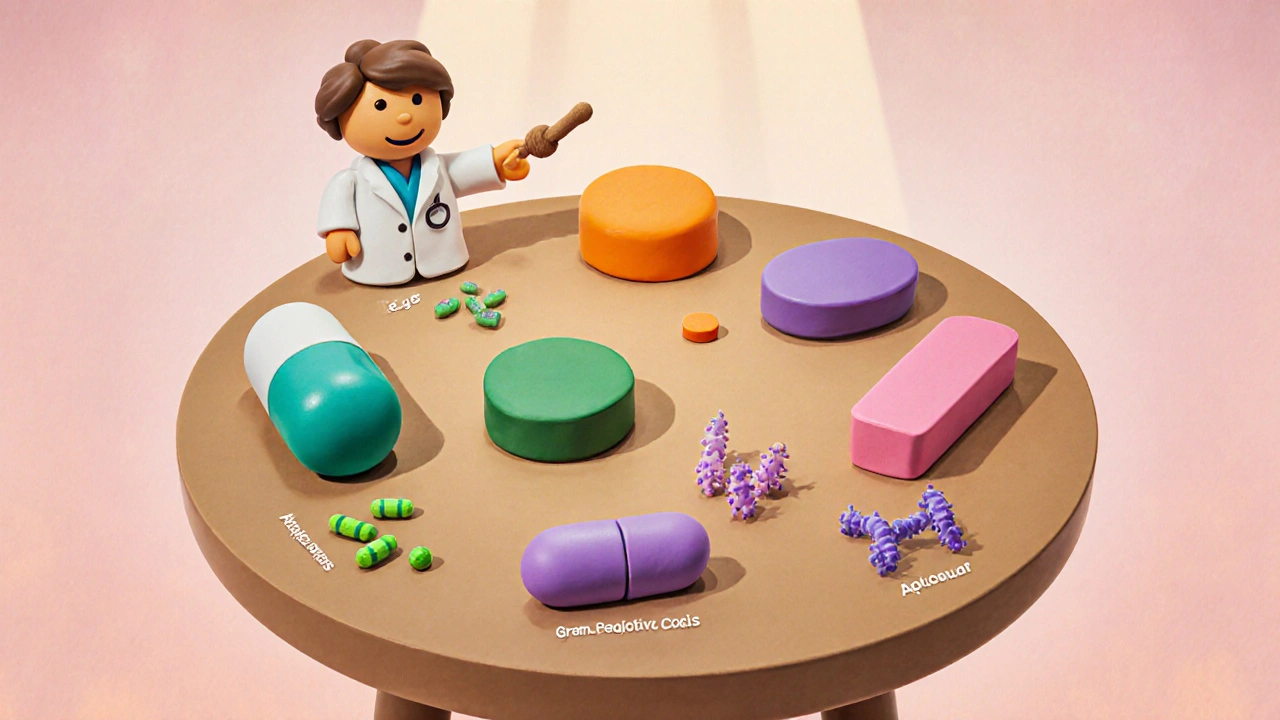Antibiotic Selection Assistant
Select Your Situation
When you or someone you care for needs a short‑acting oral antibiotic, Cefaclor (also sold as Cefaclor Monohydrate) is one of the options that often pops up. It belongs to the second‑generation cephalosporin family, which means it attacks a broad range of bacteria while usually sparing the gut flora more than older penicillins. But is it really the best choice for a sore throat, an ear infection, or a urinary tract infection? Let’s break down how it stacks up against the most common alternatives.
What makes Cefaclor different?
Cefaclor works by binding to penicillin‑binding proteins (PBPs) and halting cell‑wall synthesis. This mechanism is shared with other beta‑lactams, yet its chemical structure gives it slightly better stability against certain beta‑lactamases-enzymes some bacteria produce to destroy antibiotics. In practical terms, you’ll see Cefaclor listed for conditions like:
- Acute otitis media in children
- Uncomplicated sinusitis
- Streptococcal pharyngitis (when penicillin isn’t tolerated)
- Upper‑tract urinary infections caused by E. coli or Proteus species
The standard adult dose is 250‑500 mg every 6 hours, usually taken for 7‑10 days. For kids, the dose is weight‑based (20‑30 mg/kg/day split into three doses). Side effects tend to be mild-think nausea, occasional rash, or a transient change in liver enzymes-but severe allergic reactions can still occur, especially in patients with a history of penicillin allergy.
How do the main alternatives compare?
Below is a quick‑look table that lines up Cefaclor with four other oral antibiotics that doctors frequently prescribe for similar infections. The figures for typical UK NHS pricing are averages taken from 2024 NHS prescription data.
| Antibiotic | Class | Typical Spectrum | Usual Adult Dose | Common Side Effects | Average NHS Cost (per course) |
|---|---|---|---|---|---|
| Cefaclor | 2nd‑gen cephalosporin | Gram‑positive & some Gram‑negative (H. influenzae, M. catarrhalis) | 250‑500 mg q6h | Nausea, rash, mild liver enzyme rise | £4.80 |
| Amoxicillin | Penicillin | Broad Gram‑positive, some Gram‑negative (E. coli) | 500 mg t.i.d. | Diarrhea, skin rash | £3.20 |
| Cephalexin | 1st‑gen cephalosporin | Strong Gram‑positive, limited Gram‑negative | 250‑500 mg q6h | Stomach upset, mild allergic reactions | £4.00 |
| Azithromycin | Macrolide | Atypical bacteria, some Gram‑positive | 500 mg day 1, then 250 mg daily x4 | GI upset, QT prolongation (rare) | £6.10 |
| Clindamycin | Lincosamide | Gram‑positive, anaerobes | 150‑450 mg q6‑8h | Diarrhea, C. difficile risk | £7.50 |
When to reach for Cefaclor
If the infection is caused by bacteria that are known to produce beta‑lactamase, Cefaclor often outperforms amoxicillin because its side chain resists degradation. It’s also a good fallback when a patient reports a mild penicillin allergy-most reactions are cross‑reactive, but the overall risk with a second‑generation cephalosporin is lower than with a full‑dose penicillin.
However, Cefaclor isn’t the first line for serious pneumonia or for infections that need high tissue penetration, like bone infections. In those cases, a third‑generation cephalosporin (e.g., ceftriaxone) or a fluoroquinolone may be preferred.

Pros and cons at a glance
- Pros
- Effective against beta‑lactamase‑producing organisms
- Twice‑daily dosing possible for children (liquid form)
- Relatively low cost in the UK
- Cons
- Short half‑life → four doses a day for adults
- May cause mild liver enzyme elevation
- Not ideal for anaerobic infections (clindamycin wins there)
Decision guide: picking the right antibiotic
Think of the choice as a simple flowchart. First, ask yourself: "Is the patient allergic to penicillin?" If yes, Cefaclor or a macrolide like azithromycin become top candidates. If the infection is clearly Streptococcus pyogenes, amoxicillin remains cheapest and just as effective.
Second, consider the bacterial spectrum needed. For ear infections caused by Haemophilus influenzae, Cefaclor’s activity is a clear advantage over cephalexin. For skin and soft‑tissue infections where anaerobes are likely, clindamycin provides better coverage.
Finally, factor in patient convenience and cost. A four‑times‑daily regimen can be hard for busy adults, so a once‑daily macrolide might improve adherence, even if it costs a bit more.
Common questions from patients
Many people wonder whether they can switch from a penicillin to Cefaclor without a doctor’s approval. The short answer: don’t self‑medicate. Even though cross‑reactivity is low, an allergy specialist should confirm safety. Another frequent query is about the taste of the liquid formulation-most pharmacies add a mild fruit flavor that masks bitterness, but you can mix it with a small amount of juice if needed.
Bottom line
Cefaclor sits comfortably in the middle of the antibiotic toolbox: broad enough to tackle common community infections, yet narrow enough to limit collateral damage to the microbiome. When beta‑lactamase is a concern, or when a mild penicillin allergy bars the first line, it becomes a solid second choice. For purely gram‑positive infections or when cost is the primary driver, amoxicillin still wins. Always let a prescriber weigh the infection type, patient history, and convenience before settling on a final pick.
Can I take Cefaclor if I’m allergic to penicillin?
Mild penicillin allergies usually don’t cross‑react with second‑generation cephalosporins like Cefaclor, but severe IgE‑mediated reactions can. Talk to your doctor or an allergist before switching.
How long should I stay on Cefaclor?
Typical courses run 7‑10 days for most respiratory or ear infections. Shorter courses may be appropriate for uncomplicated sinusitis, but always follow the prescriber’s instructions.
Is Cefaclor safe during pregnancy?
Category B in the UK, meaning animal studies have not shown risk and there are no well‑controlled studies in pregnant women. It’s generally considered safe when benefits outweigh risks.
What should I do if I develop a rash while on Cefaclor?
Stop the medication immediately and seek medical advice. A rash can be an early sign of an allergic reaction that may progress.
How does Cefaclor compare to azithromycin for sinus infections?
Cefaclor covers the typical bacterial culprits (Streptococcus, Haemophilus) better than azithromycin, which is more useful for atypical pathogens. However, azithromycin’s once‑daily dosing may improve adherence for some patients.

